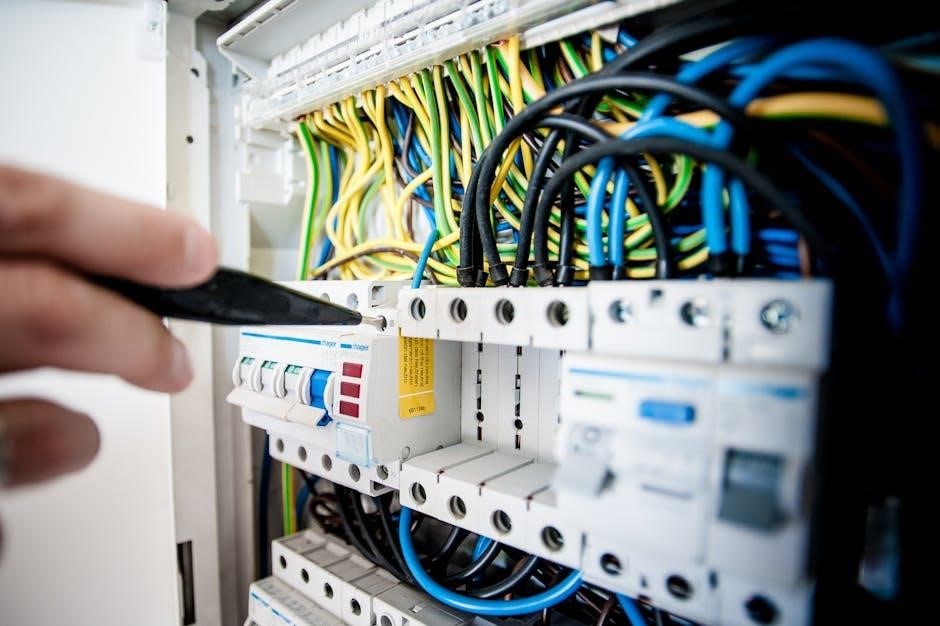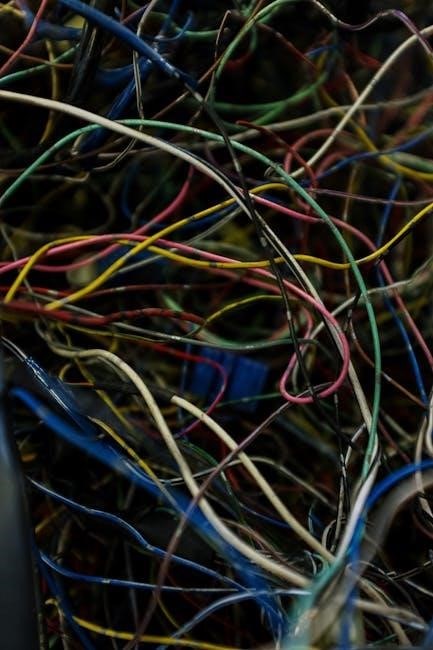Strat wiring is fundamental to optimizing your electric guitar’s sound and versatility. Understanding the basics ensures proper functionality and tonal variety, making it essential for players and DIY enthusiasts alike.
1.1 Understanding the Basics of Stratocaster Electronics
Stratocaster electronics involve pickups, tone controls, a volume potentiometer, and a 5-way pickup selector. Single-coil pickups capture a bright, dynamic sound, while humbuckers reduce noise. Tone controls adjust high-frequency response, and the 5-way switch selects pickup combinations. Proper wiring ensures these components function seamlessly, delivering the iconic Strat tone and versatility that players rely on for diverse musical styles and preferences.
1.2 Importance of Proper Wiring for Tone and Functionality
Proper Strat wiring ensures optimal tone clarity and functionality. Correct connections prevent signal loss, hum, and noise, preserving the guitar’s natural resonance and dynamic range. Accurate wiring also guarantees reliable operation of pickups, tone controls, and the pickup selector, allowing players to achieve their desired sound effortlessly.
Improper wiring can lead to tonal inconsistencies, intermittent issues, and reduced playability, making it crucial for both tone and performance.
Standard Strat Wiring Configurations
Standard Strat wiring configurations include SSS, HSS, and HHH setups, each offering unique tonal options. These configurations determine pickup combinations and switching options, catering to diverse playing styles and musical genres.
2.1 SSS (3 Single-Coil Pickups) Wiring Diagram
The SSS configuration features three single-coil pickups, providing a classic Stratocaster tone with a 5-way selector switch. This setup allows for a variety of tonal options, including bridge, middle, and neck pickup combinations, as well as the iconic in-between sounds. The wiring diagram typically includes a master volume, two tone controls, and the standard 5-way switch, ensuring a versatile and dynamic sound. Players often prefer this configuration for its bright, crisp tones and ability to achieve a wide range of musical styles. The SSS wiring is a staple for many guitarists seeking the authentic Stratocaster experience.
2.2 HSS (Humucker-Single-Single) Wiring Diagram
2.2 HSS (Humbucker-Single-Single) Wiring Diagram
The HSS configuration combines a humbucker at the bridge with single-coil pickups in the middle and neck positions. This setup reduces hum in the bridge position while maintaining the Strat’s signature clarity and versatility. The wiring diagram typically includes a 5-way switch, master volume, and two tone controls. The humbucker adds warmth and sustain, making it ideal for players seeking a balance between classic Strat tones and modern, high-gain sounds. This configuration is popular for its adaptability across various musical genres.
2.3 HHH (3 Humbucker Pickups) Wiring Diagram
The HHH configuration features three humbucker pickups, offering a robust, full-bodied sound with minimal hum. This wiring diagram typically includes a 5-way switch for pickup selection, a master volume control, and tone controls for each humbucker. The setup provides a wide tonal range, from smooth, vintage tones to aggressive, modern sounds. It’s ideal for players seeking high-gain versatility and reduced noise, making it perfect for rock, metal, and hard-hitting genres.
Key Components of Strat Wiring
Pickups, tone controls, volume pot, output jack, and selector switch are essential components. They work together to shape the guitar’s sound and functionality effectively.
3.1 Pickups and Their Roles
Pickups are the heart of your Strat’s tone, capturing string vibrations. Single-coil pickups deliver bright, crisp sounds, while humbuckers offer fuller tones with reduced hum. The Strat typically features three pickups—bridge, middle, and neck—each with distinct tonal characteristics. They can be combined in various configurations to achieve a wide range of sounds, from clean and articulate to heavy and aggressive, making them versatile for different musical styles and preferences.
3.2 Tone Controls and Potentiometers
Tone controls and potentiometers are crucial for shaping your Strat’s sound. Typically, a 250k or 500k potentiometer is used, depending on the pickup type. These controls adjust the high-frequency response, allowing you to dial in brightness or warmth. Proper wiring ensures smooth operation, while upgrades like custom pots or tone caps can refine the tonal palette for enhanced clarity or vintage-style resonance, catering to various musical preferences and playing styles.
3.3 Volume Control and Output Jack
The volume control potentiometer regulates the overall output level, while the output jack ensures a secure connection for your cable. Proper installation prevents signal loss and hum, with quality components like a 250k or 500k pot and a sturdy jack being essential for reliable performance and clear tone transmission, ensuring your Strat sounds its best through any amplifier or effects setup.
3.4 The 5-Way Pickup Selector Switch
The 5-way selector switch allows players to choose between different pickup configurations, offering a wide range of tonal options. Positions include bridge, middle, neck, and combinations like bridge-middle and middle-neck. This versatility enables players to achieve diverse sounds, from crisp bridge tones to warm neck tones, making it a key component for exploring the Stratocaster’s legendary versatility and tonal variety. Proper wiring ensures smooth transition between selections.
Tools and Materials Needed for Strat Wiring
Essential tools include a soldering iron, solder, shielded wire, and a multimeter.
Proper materials ensure reliable connections and optimal tone in your Stratocaster.
4.1 Soldering Equipment and Supplies
A soldering iron with adjustable temperature control is essential. Use high-quality solder (60/40 tin-lead) and flux for clean connections. A desoldering pump and wire strippers are also necessary. Always have safety gear like gloves and goggles. Proper soldering tools ensure reliable, noise-free connections and prevent damage to components. Invest in a soldering stand and keep a damp sponge handy for tip cleaning during work.
4.2 Types of Wire and Cable
For Strat wiring, use high-quality 22 AWG (American Wire Gauge) stranded wire for durability and flexibility. Shielded cable is crucial for reducing hum, especially with single-coil pickups. Vintage-style cloth-covered wire is popular for its aesthetic appeal and tone. Ensure proper insulation and gauge for reliable connections. The right wire ensures minimal signal loss and optimal tonal clarity, making it a critical choice in your Stratocaster setup.
4.3 Other Essential Tools for the Job
Besides soldering gear, essential tools include wire strippers for clean wire preparation, screwdrivers for potentiometer and switch adjustments, and a multimeter to test connections. Heat-resistant pads or mats protect your work surface, while a magnifying glass aids precision. Tweezers and small clamps help manage wires, ensuring a tidy setup. A well-organized toolkit streamlines the wiring process, reducing errors and enhancing efficiency for a professional finish.

Safety Tips and Best Practices
Always handle electronics safely, avoiding soldering near flammable materials. Use proper soldering techniques to prevent shorts and ensure reliable connections. Inspect wiring regularly for wear or damage.
5.1 Handling Electronics Safely
When handling electronics, ensure soldering irons are used with heat-resistant surfaces. Always unplug the guitar before starting work to avoid electrical shocks. Wear protective eyewear and keep flammable materials away. Proper grounding techniques can prevent static damage to components. Regularly inspect wires for frays or damage to maintain safety and functionality during soldering processes.
5.2 Avoiding Common Mistakes in Wiring
Common wiring mistakes include incorrect solder joints, reversed polarity, and insufficient shielding. To prevent these, use clear diagrams, verify connections before soldering, and ensure proper insulation. Shielding cables reduce hum, while correct polarity maintains pickup balance. Double-checking each step minimizes errors, ensuring reliable performance and optimal tone from your Stratocaster, thus enhancing both functionality and sound quality effectively and efficiently.

Common Strat Wiring Modifications
Popular mods include coil-splitting, blender pots, and tone capacitor changes. These enhancements expand tonal versatility, offering players unique sonic possibilities while maintaining the Strat’s signature clarity and feel.
6.1 Coil-Splitting for Expanded Tonal Options
Coil-splitting modifies humbuckers to access single-coil tones, enhancing versatility. By engaging a push-pull pot or mini-switch, one coil deactivates, delivering crisp, snappy sounds; This mod retains the humbucker’s full tone while adding single-coil clarity, ideal for players seeking tonal variety without sacrificing the Strat’s signature character.
6.2 Adding a Blender Pot for Pickup Blending
A blender pot allows seamless mixing of pickups, creating unique tonal combinations. By wiring it to blend neck and bridge pickups, you can achieve a wide range of sounds. Installation typically involves a variable resistor and basic soldering, offering enhanced versatility without altering the guitar’s original circuit.
6.3 Changing Tone Capacitors for Different Tonal Responses
Swapping tone capacitors alters the high-frequency roll-off, shaping your guitar’s tonal character. Using smaller capacitance values (e.g., 0.047μF) yields brighter tones, while larger values (e.g., 0.1μF) produce warmer, vintage sounds. Experimenting with different caps allows you to tailor the treble response to your playing style and musical genre, enhancing the overall versatility of your Stratocaster.

Troubleshooting Common Wiring Issues
Identify issues like hum, noise, or intermittent connections by inspecting solder joints and wire connections. Ensure proper grounding and check for loose or corroded terminals to resolve problems effectively.
7.1 Diagnosing Intermittent Connections
Intermittent connections can cause frustrating issues like crackling sounds or sudden loss of signal. Start by inspecting all solder joints for cracks or poor connections. Wiggle wires gently to detect any breaks or loose points. Use a multimeter to test continuity and resistance, ensuring no open circuits. Clean or resolder faulty areas to restore reliability and consistent tone.
7.2 Fixing Hum or Noise in the Signal Path
Hum or noise in your Strat’s signal path can often be traced to poor shielding, grounding issues, or low-quality components. Ensure all electronics are properly shielded, and check for frayed or damaged wires. Replace noisy tone capacitors with high-quality alternatives. Verify that the output jack is securely grounded and free from corrosion. Upgrading to noise-reducing pickups, like humbuckers, can also help eliminate unwanted interference and improve overall clarity.

Advanced Strat Wiring Upgrades
Explore advanced upgrades like installing active electronics for boosted output or adding a MIDI interface for modern applications, enhancing your Strat’s versatility and adaptability to new sounds.
8.1 Installing Active Electronics
Installing active electronics enhances your Strat’s tonal capabilities by introducing powered circuits. Active pickups or preamps boost output, reduce hum, and expand tonal options. This upgrade requires soldering expertise and compatibility checks. Modern players often prefer active systems for clarity and versatility, making it a popular advanced modification. Ensure proper shielding and power supply integration for optimal performance and noise reduction.
8.2 Adding a MIDI Interface for Modern Applications
Adding a MIDI interface transforms your Strat into a versatile tool for modern music production. This upgrade allows connection to synthesizers, effects processors, and digital recording systems. A MIDI pickup or hex pickup captures string vibrations, converting them into digital signals. Installation requires routing the signal through the MIDI interface and integrating it with your guitar’s electronics. This modification opens up endless tonal possibilities for experimental and tech-savvy musicians.

Resources for Further Learning
Explore detailed wiring diagrams at Seymour Duncan and Fender’s official guides. Join forums like TDPRI for discussions and troubleshooting tips. Download PDF resources for custom mods and upgrades.
9.1 Recommended Wiring Diagrams and Schematics
Visit Seymour Duncan for detailed diagrams, including the Strat SSS1 blender wiring. Explore Fender’s official guides for standard configurations. Check forums like TDPRI for community-shared schematics and mods. Download PDF resources for humbucker and single-coil setups, ensuring accurate and customizable wiring solutions for your Stratocaster.
9.2 Online Communities and Forums
Online communities like TDPRI, Seymour Duncan forums, and Fender discussion boards are invaluable for Strat wiring guidance. They offer detailed troubleshooting tips, DIY modifications, and custom wiring ideas. Engage with enthusiasts and experts to solve issues, explore new configurations, and enhance your guitar’s sound. These platforms foster collaboration, making them essential for both novices and experienced players alike.
Mastering Strat wiring enables customization and enhances tone. Explore modifications, and embrace the DIY spirit to unlock your guitar’s full potential and unique sound.
10.1 Summarizing the Key Points
10.2 Encouragement for DIY Exploration
Exploring Strat wiring modifications is a rewarding journey for guitar enthusiasts. With patience and practice, you can unlock new tones and customize your instrument to suit your style. Start with simple mods like coil-splitting or tone capacitor swaps, then gradually experiment with more complex upgrades. Remember, every tweak brings you closer to your ideal sound, making DIY a fulfilling path to musical expression.

References
Refer to reputable sources like Seymour Duncan’s wiring diagrams and Fender’s official guides for accurate and detailed Strat wiring information.
11.1 Crediting Sources and Inspirations
Credit goes to Seymour Duncan for detailed wiring diagrams and Fender’s official guides for Stratocaster electronics. Online forums like TDPRI and resources from guitar tech communities provide invaluable insights and inspiration for DIY projects and customizations.

